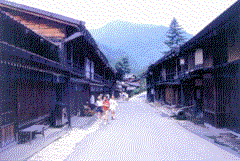

 |
||

|
Post Towns that Conjure Up the Feudal Ages
 Tsumago-juku and Magome-juku, two towns in southwestern Nagano Prefecture, were prosperous post towns during the Edo period (1603-1868). Two roads linked Edo (present day Tokyo), the seat of the Shogunate, with Kyoto in those days. One was the Tokaido, which followed the coastline and had 53 way stations, and the other was the Nakasendo, which traced a route through the mountains and had 69 way stations. Tsumago-juku and Magome-juku were both post towns on the Nakasendo. The function of these sort towns, which were located all around the country in the Edo period, was similar to the role of railway stations in a modern context. There were inns, and eating and drinking establishments as well as carriers and horses to transport travelers and official documents to the next station on the road. Travelers and merchants catering to travelers gathered here and the towns flourished as a result. With the development of railway and automobile transportation early this century, those post towns lost their traditional function and most of them modernized. However, Tsumago-juku and Magome-juku, nestled deep in the mountains, preserved their historical appearance through the wishes of the local residents. Roads in the historical preserve are paved with stones, and telegraph poles, glass windows and other artifacts of modern civilization are nowhere to be seen. Another function of the original post towns was that of a present-day post office, and to this day, the postal workers of Tsumago deliver the mail on foot, wearing a bamboo hat and traditional cotton livery called happi just as in the Edo period. Photos: Tsumago-juku (Nagano Prefecture) Unauthorized reproduction of the photos in this page is prohibited.
Related Links: |
|

